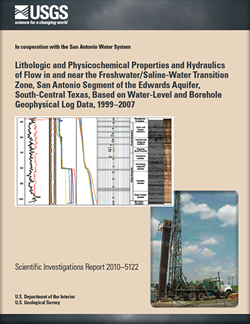Scientific Investigations Report 2010–5122

The freshwater zone of the San Antonio segment of the Edwards aquifer in south-central Texas (hereinafter, the Edwards aquifer) is bounded to the south and southeast by a zone of transition from freshwater to saline water (hereinafter, the transition zone). The boundary between the two zones is the freshwater/saline-water interface (hereinafter, the interface), defined as the 1,000-milligrams per liter dissolved solids concentration threshold. This report presents the findings of a study, done by the U.S. Geological Survey in cooperation with the San Antonio Water System, to obtain lithologic properties (rock properties associated with known stratigraphic units) and physicochemical properties (fluid conductivity and temperature) and to analyze the hydraulics of flow in and near the transition zone of the Edwards aquifer on the basis of water-level and borehole geophysical log data collected from 15 monitoring wells in four transects during 1999–2007. No identifiable relation between conductivity values from geophysical logs in monitoring wells in all transects and equivalent freshwater heads in the wells at the times the logs were run is evident; and no identifiable relation between conductivity values and vertical flow in the boreholes concurrent with the times the logs were run is evident. The direction of the lateral equivalent freshwater head gradient and thus the potential lateral flow at the interface in the vicinity of the East Uvalde transect fluctuates between into and out of the freshwater zone, depending on recharge and withdrawals. Whether the prevailing direction on average is into or out of the freshwater zone is not clearly indicated. Equivalent freshwater head data do not indicate a prevailing direction of the lateral gradient at the interface in the vicinity of the Tri-County transect. The prevailing direction on average of the lateral gradient and thus potential lateral flow at the interface in the vicinity of the Kyle transect likely is from the transition zone into the freshwater zone. The hypothesis regarding the vertical gradient at the East Uvalde transect, and thus the potential for vertical flow near an interface conceptualized as a surface sloping upward in the direction of the dip of the stratigraphic units, is that the potential for vertical flow fluctuates between into and out of the freshwater zone, depending on recharge and withdrawals. At the Tri-County transect, a downward gradient on the freshwater side of the interface and an upward gradient on the saline-water side are evidence of opposing potentials that appear to have stabilized the position of the interface over the range of hydrologic conditions that occurred at the times the logs were run. At the Fish Hatchery transect, an upward gradient on the saline-water side of the interface, coupled with the assumption of a sloping interface, implies a vertical gradient from the transition zone into the freshwater zone. This potential for vertical movement of the interface apparently was opposed by the potential (head) on the freshwater side of the interface that kept the interface relatively stable over the range of hydrologic conditions during which the logs were run. The five flow logs for Kyle transect freshwater well KY1 all indicate upward flow that originates from the Glen Rose Limestone, the uppermost unit of the Trinity aquifer; and one log for well KY2 shows upward flow entering the borehole from the Trinity aquifer. These flow data constitute evidence of the potential for flow from the Trinity aquifer into the Edwards aquifer in the vicinity of the Kyle transect. Subsurface temperature data indicate that flow on average is more active, or vigorous, on the freshwater side of the interface than on the saline-water side. A hydraulic connection between the transition zone and the freshwater zone is indicated by similar patterns in the hydrographs of the 15 transect monitoring wells in and near the transition zone and three county index wells in the freshwater zone during 1999–2007. The data for this report in part support a conceptualization of regional flow in and near the transition zone in which water enters the transition zone from the freshwater zone in the western part of the Edwards aquifer, flows toward the northeast, and discharges to the freshwater zone in the eastern part of the aquifer. The data for this report support the hypothesis that the interface is likely to remain stable laterally and vertically over time. The most direct evidence in support of that hypothesis is the conductivity data from Tri-County transect well TC2 and Kyle transect well KY2 that show an essentially stable vertical interface position (depth in the borehole) over a range of hydrologic conditions. No single line of evidence confirms the hypothesis that the interface in the San Antonio segment of the Edwards aquifer is relatively stable over time, and thus the potential for irreversible movement of saline water into the freshwater zone is small; but the cumulative evidence from the water-level (head) and borehole geophysical log data supports that hypothesis. |
Posted November 1, 2010
For additional information contact: Part or all of this report is presented in Portable Document Format (PDF); the latest version of Adobe Reader or similar software is required to view it. Download the latest version of Adobe Reader, free of charge. |
Lambert, R.B., Hunt, A.G., Stanton, G.P., and Nyman, M.B., 2010, Lithologic and physicochemical properties and hydraulics of flow in and near the freshwater/saline-water transition zone, San Antonio segment of the Edwards aquifer, south-central Texas, based on water-level and borehole geophysical log data, 1999–2007: U.S. Geological Survey Scientific Investigations Report 2010–5122, 69 p.
Abstract
Introduction
Methods of Analysis
Lithologic and Physicochemical Properties
Hydraulics of Flow
Summary
References
Appendixes 1.1–1.15 (available online only)